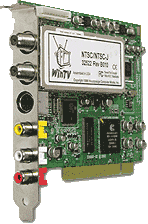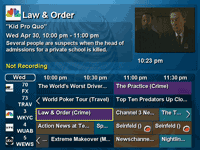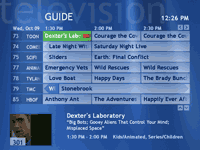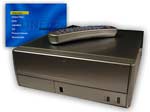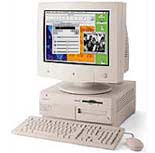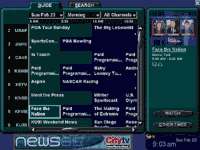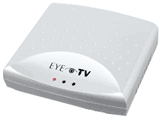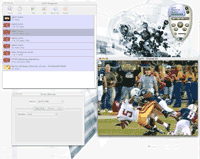
EyeTV by El Gato provides flexible
TV recording and viewing options.
I like Macs. A lot. My first Mac was the result of a direct need to use the computer that graphics professionals were using the real world. Within a week of my first startup chime I was hooked. It was intuitive, reliable, and dare I say… fun?! I would have loved to build a Mac-based solution, but the current offerings are expensive. The only consumer-ready integrated media solution is eyehome (once again from El Gato Systems). This appliance uses your existing Mac and an EyeTV interface via a network connection to view recorded telivision, listen to music, watch videos and photo slideshows, and browse the web. My main complaint is not resolved by this solution, the only TV listing solutions available are web-based… and you can’t access the tv recording features directly from eyehome… you still have to run to your Mac to start or schedule a recording. Since this solution still uses my main computer, requires an EyeTV in addition to the eyehome appliance, it’s simply too complicated and expensive to consider… and I really want an onscreen guide to browse tv shows and schedule recordings!
The options I would consider were:
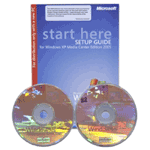
Windows XP Media
Center Edition 2005
Microsoft’s new “Windows XP Media Center Edition 2005“. Personally, I would have like to see a Type-R tacked onto that bloated handle. (What the hell? They couldn’t decide which naming standard to go with? Make up your mind Bill… stick to editions (ME, NT, XP), versions (3.11), or years (95, 98, 2004). Don’t try to cram them all onto the box!)
SnapStream’s Beyond TV for Windows, an application for recording and viewing television that can be controlled via remote.
MythTV or more accurately KnoppMyth which offers a “simplified” Linux installation and hardware detection process… more on that later.
I began to investigate these options on my existing “theater” PC. An aging Windows XP machine connected to my home theater system. It consists of a 1.1 ghz Athlon, 256 megs of RAM, ATI 7500 video card, the aforementioned BT878 tuner card, and a lowly 40 gb hard drive. I admit, I was being incredibly optimistic. But, I figured I would try to get this working with as little investment as possible.
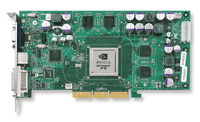
NVidia’s GeForce FX
I first tried to install XPMCE2005(Type-R) on top of my existing XP Pro environment despite dozens of online rants against such a folly. After 2 tries, I decided that this would indeed call for a reload. But, rather than try XPMCE2005(Type-R STi) from the get-go, I went with my gut instinct and installed KnoppMyth… sort of. The instructions offered were simple and straight-forward. The actual process, was, unsurprisingly, not. Ideally, the live cd (once burned) should boot up, detect all of my hardware, prompt me for a few simple settings, and install itself. Easy enough… but, don’t let the system go to sleep while installing. It locks up. Hardcore. Keep tapping a control key to avoid sleep at all costs.
Once that obstacle was overcome, the installation completed and prompted me for a reboot. It successfully restarted, went through the usual Linux initialization scripts and started X… technically. I was greeted with an obviously out-of-sync television display. I know there must have been something really cool to see, but damned if I could. I immediately Control-Alt-F1’ed to the console, logged in, and began poking through the XF86Config file (which controls many settings for the behavior of the X sessions display including vertical and horizontal sync, color depth, resolution, ad nauseam). An our later and I resorted to the MythTV web forums for support. Plain and simple, ATI’s Linux support was mediocre at best. God help you if you wanted to use the TV-out functionality of the video card. Strike 1… and I have a feeling there’s going to me more than 3 strikes total in this game.
Since that attempt was now null and void, why not try XPMCE2005(Type-R STi J-Spec)? This is the first Windows installation that requires 2 CDs. (Why not just use a single DVD, Bill?) This installation was as straightforward as Windows gets. Browsing the License Agreement(s) took more mouse clicks than the rest of the installation, but about 40 minutes later, XPMCE2005(Type-R STi J-Spec Turbo) was installed. My first reaction was indifference. It looked like regular old XP with a slightly updated (simplified) theme. I clicked into the start menu to find an unfamiliar icon for the Media Center. That’s when it happened. I would have been no less surprised if the sound of an Autobot transforming erupted from my speakers. I was no longer looking at a keyboard-and-mouse-navigated desktop, but a simplified, appliance-like interface that was both feature-rich, and incredibly simple. Even my parents would more likely be confused by a DVD menu than this! Immediately I headed for the settings. (The TV option wasn’t available to my chagrin.) Here’s where things started to go awry. A message appears notifying me… nay… taunting me with the fact that my video card was not compatible with Media Center. I was a little surprised by this, but after a quick visit microsoft.com, I confirmed that a DirectX 9-compatible card was required. It was official, my first required upgrade is a video card. While researching this, I also discovered that my 1.1 ghz Athlon was not up to par, either. While this hardware may still work with MythTV, there was a good chance that it would not be beefy enough to handle recording live tv.
Even though my video card was shunned by the Media Center, I was allowed to click around. I continued to the tv settings and found that my tuner card was also incompatible. Bah. Time to stop and evaluate my options.
Both MythTV and MCE would require a new video card. MythTV was more friendly with the Nvidia offerings than those from ATI. MythTV appeared to recognize my tuner during the boot sequence, but I was unable to test this without getting all of the way into the interface. There was a good chance that I would need to power-up in the hardware department. 1 ghz just wasn’t going to cut it.
After some research, I decided that Nvidia’s budget-minded GeForceFX 5200 was the route to take. I could replace my motherboard and processor inexpensively. After a few hardware swaps with friends and a delivery from my hero, the UPS guy, I was ready to try again. The updated specs? Athlon 2600+, 266 fsb, 726 megs of RAM. Would you like fries with that?
Back to MythTV. I was becoming an old pro at this installation stuff. I got the installation down to about 20 minutes. I booted into X (yay!), hopped out of the gui, made changes via the console to the XF86Config file, and I was in business. Kinda. The instructions stated that I should run a command-line installer to get the Nvidia drivers installed and the processor-specific apps installed. A few days had passed since my last swing at this, so I had forgotten about this completely. Fast forward a bit, I had had righted my wrongs. (BTW – the folks on the discussion boards weren’t kidding about the advanced Nvidia support. From overscan to refresh rate and video acceleration, you can tweak it in the XF86Config file.)
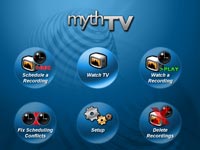
MythTV’s Refined User Interface
My vigilance was rewarded with the most polished Linux interface I have yet encountered. Smooth screen transitions and easy-to-use navigation ooze from the MythTV GUI. Heading straight for the TV settings, I was once again informed that my card was incompatible. (Actually, it said that it was already in use and recording a program. Which universe this was occurring in was unknown to me. So, let’s assume it meant to say that my card was just plain crap.) Fine, I could probably fudge with the config files and get it to work. A few years ago, I had proven that I could use this tuner with Video 4 Linux… I also remember what a horrendous pain the arse it was. Not yet ready to dive into such an endeavor, I decided to mount my shared video directory from my home control server. Easy enough. The video all appeared in the user interface. A double click later and all I get for my effort was a 1/2 second loading screen, then nothing. Nice. Undeterred, I then mounted my music and played a few MP3s. Finally, success! I checked out a few of the additional features offered by MythTV which included an impressive weather plug-in and a (very) simple RSS aggregator. The GUI occasionally locked, but could be restarted with some command line magic. It should be noted that MythTV is controlled exclusively via keyboard/remote. There is no mouse support at all. Personally, I didn’t like this, especially when it came time to make my mp3 playlists. However, others may be indifferent to this “feature” Time to see what Chairman Bill could do for me.
I admit I felt a little dirty when I began re-installing Windows. MythTV was so close to what I wanted… I reminded myself to remain neutral until I had evaluated my options fully. Once again Windows was installed and I was back into the Media Center. This time there was no warning regarding my video card. However, there was still no TV tuner goodness. (I noted that even though I had doubled the processor mhz and tripled the RAM, the Media Center interface was no more responsive than before.) Mounting my network shares, and viewing pre-existing mpegs was an exercise in simplicity. However, viewing DVDs and non “standard” mpeg files was a little more convoluted. Codecs are the magic ingredient here.
Without the right collection of codecs, forget watching DVDs. Forget watching mpeg4 videos (I require this to watch my collection of Computer Chronicles episodes, many of which are only available in this format.) and forget watching anything Quicktime (at least from within Media Center proper). Luckily, the CD that came with my Nvidia card contained a DVD decoder. Next, I visited 3ivx and Divx websites to download their free codec offerings. Quicktime was downloaded and installed as a stand-alone (no MCE-integrated) app. Media Center and Windows Media Player still pause for nearly a minute while trying to download the “right” codec for mp4 files, but eventually plays them. DVD playback is nice, but the picture quality is noticeably lower than that of my dedicated DVD player (partially due to the s-video connection on my video card vs. the component video available on my DVD player). The MCE interface generates thumbnails of each video in my library, which is nice, but mostly useless (since just about every Adult Swim series starts with the same first frame).
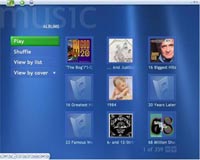
Media Center Music Interface
Music playback is very nice. MCE retreives the cover art and album information for both CDs and MP3s from the internet. The playlist interface is a bit clunky and non-intuitive, but functional. (The playlist functionality for the video player is notably absent.) Visualizations are the standard Windows Media Player fare.
I came across some simple add-ons for MCE. One allowed me to view my NetFlix queue, new relases, and most popular rentals. Another offered a simple weather display (nothing nearly as elegant and useful as the one featured in MythTV). I added QuickTime to my list of “Other Programs” so I could access the application from within Media Center. It operates independantly, minimizing Media Center during playback.
At this point, I was starting to lean towards MCE as my solution. I haven’t even tried Beyond TV. I wanted a solution that worked without unneccesary complication. MythTV was nice, but not yet a complete, consumer-ready solution. But, I haven’t even tried the TV functions for either solution yet. Would I change my mind or would I just loose it?
Continued in Part 3…
Read Part 1…
- Duane
 Pictures
Pictures